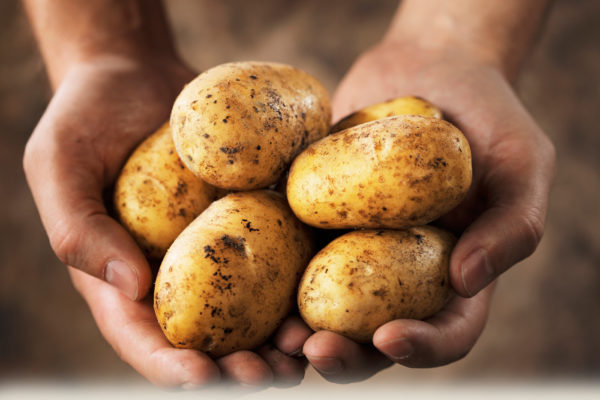
Proper care of potatoes is one of the prerequisites for obtaining a decent reward for their tireless work. Knowing how to care for a good harvest, you can achieve excellent performance and repeatedly increase the volume of planted material.
In winter, strong large tubers will serve as a worthy help for a healthy and nutritious diet, pleasantly diversify the daily table. A potato cooked in any form is one of the main and favorite dishes inherent in our national mentality. Its use has no pronounced contraindications in any disease. The mastery of the hostess allows using it not in one dozen dishes, but careful and careful storage - to survive on the stock received until the new crop.
What should be the care of potatoes, how to care, in the usual way, which was adopted by the parents, or the scientific, recommended portals for gardeners, so that there is a good harvest, the beginning vegetable grower decides on his own. Some believe that they have enough of their practical experience, while others look at reviews, recommendations and photos in order to increase the effectiveness of their work and increase the return of a small garden.
Cultivation for industrial purposes sometimes does not allow you to take all the recommended measures to improve the efficiency of the field. A small or medium plot can be justified with the use of scientific and practical developments in order to rejoice at the resulting crop. Potato is a culture that gratefully responds to care, and is able to reward a gardener with a plentiful result during the harvest period.
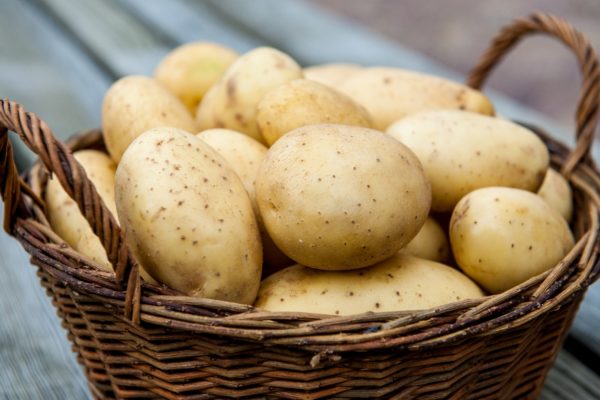
Content
Vegetable care and its features
Caring for potatoes for a person who is constantly doing this is a chain of consistent and necessary rituals that starts immediately after harvesting in the fall, when an amateur gardener goes out to dig up the garden. Earth is dug up no more than a bayonet on a shovel so as not to destroy the ecosystem of beneficial soil bacteria. More fundamentally, opponents of chemical fertilizers after that close the plot by cutting from straw, removed plants and other organic good, the rest make chemical so that the crop is high.
Caring for potatoes involves several stages, and each of them works at a strictly defined time:
- the introduction of organic fertilizers to maintain soil balance, which otherwise will be restored only at the beginning of June (useful components will freeze over the winter);
- soil water retention, or their outflow from the site, with the help of elementary devices - grooves for drainage and shelter;
- selection, disinfection and preliminary germination of planting material, varietal preferences, protecting it from thermal influences;
- proper planting, in an arched hole, at an optimal distance (a dense landing will lead to a species struggle, a rare one will give room for weeds);
- hilling, thanks to which the roots forming the tubers can maximize the use of the surrounding underground space;
- air irrigation, contributing to the enrichment of the soil with nitrogen;
- top dressing, which should be carried out at a strictly defined time and consist of a set of substances necessary for the plant in a specific period;
- watering, its dosage in various weather conditions;
- correct and qualified harvesting.
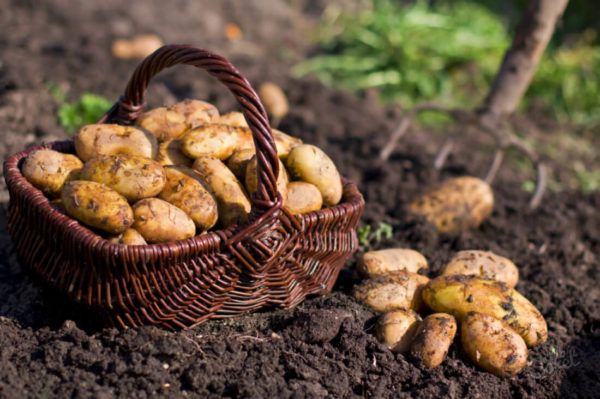
To learn how to care for potatoes so that there is a good harvest, at the same time spend the minimum amount of material resources and efforts and get full value, you can not only from scientific manuals and publications, but also from your own experience. Many scientific developments have grown from practical observations, the introduction or exclusion of certain processes.
Potato harrowing
Harrowing is one of the ways how to care for potatoes, carried out by a rake in the area of personal use, or by a tractor with the appropriate device (harrow) on the fields on an industrial scale.
Its main goals are:
- the destruction of weeds, achieved by the destruction by the teeth of the adaptation of the upper layer of the soil in which the weeds take root;
- providing potato bushes with air, which contains oxygen and nitrogen, necessary for the development of the plant (the crust formed on the soil prevents its penetration);
- the destruction of soil capillaries that appeared after the sun had dried the soil (the moisture accumulated in them goes to the roots of the potato bush.
Autumn and spring harrowing of the field is carried out to pull away organic fertilizer and prepare for spring crops. For this, devices with different teeth are used, and the process itself is carried out twice, at different angles of inclination to the soil. The type of harrow also depends on the composition of the soil. After planting, potatoes are harrowed during the day so that the destroyed weeds have time to dry in the sun, and do not give repeated shoots.
Until the bushes grow to 15 cm, harrowing can be done weekly. At the same time, about 1% of bushes die on the field. In a small area, losses can be avoided by carefully applying a rake.
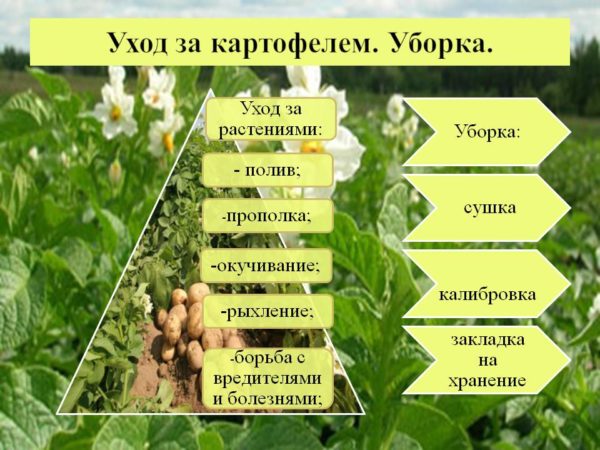
Potato cultivation
One of the secrets of how to properly care for potatoes. Sometimes it is excluded from the care process, believing that subsequent harrowing will quite cope with its functions, but experienced vegetable growers consider it an indispensable condition for a good harvest. On the field it is carried out by a small harrow. Designed for loosening the topsoil and destroying weed seeds while potato sprouts are sitting in the ground. The plot is carried out using a rake to a shallow depth. It is necessary so that the plant does not waste vitality on the penetration of the sprout through a hard crust.
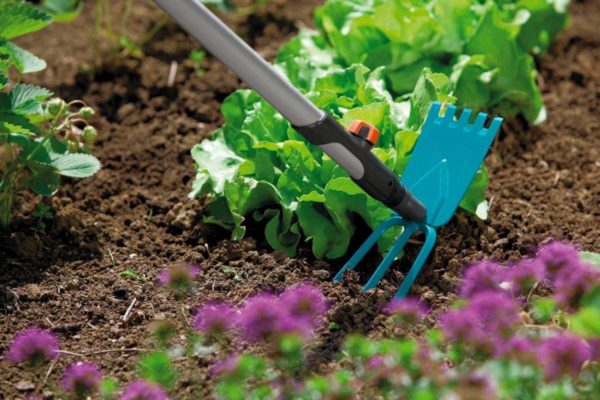
Hilling potatoes
Not everyone knows how to care for potatoes to have a good harvest. Hilling is one of the main tricks of this care.
This is the sprinkling of earth on the bottom of the potato bush, which at different times is carried out to achieve a specific goal:
- prevent weed growth;
- giving the soil friability and permeability, which makes it possible to freely penetrate moisture and air;
- creating a thermos effect to protect the sprout from the wind and frost;
- sustainability of the young bush;
- growth intensification (the plant begins to reach for the sun, more branches and leaves appear on the bush).
First, antithermal hilling is carried out when the sprouts have reached 5 cm. This is done to preserve the sprout. The second - after the plant reaches 15 cm in height, for the first flowering - for better growth and development of future tubers. Unscheduled - if the bushes stretched out and lay on the soil. It is carried out to give stability and protect tubers from the destructive sun.
Classical hilling involves a two-time procedure, but it can be carried out in two different ways. Fan - when the earth is raked strictly around the bush, high - the soil is raked to the center, and the branches of the plant are bred a little to the side. Both this and the other method have supporters and opponents. High is more often used in northern regions, when the choice of the method of how to care for potatoes ensures its maximum resistance to weather influences.

Watering potatoes
Watering is necessary for potatoes only during the flowering period, preferably with top dressing, although much depends on the weather. Moderate precipitation and sunny weather in rotation suggest the absence of additional moisture, although for some housewives care for potatoes in July involves a little watering in case of intense heat and cracked soil.
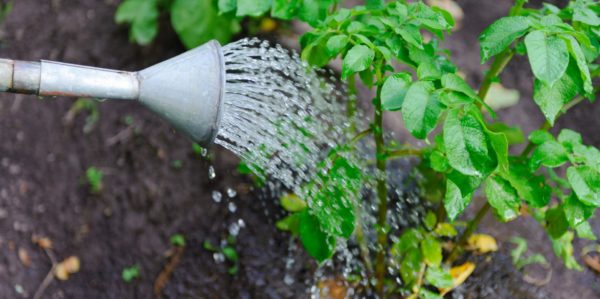
Potato dressing
A classic and proven option - three times feeding the plant:
- when growth occurs, and foliage and stems are pale and not intensively developed (humus and urea);
- when buds form to speed up flowering (ash and potassium sulfate);
- when the fruits of the vegetable grower's tireless labor begin to develop (superphosphate, or superphosphate with potassium sulfate and nitrophosphate).
Reviews of experienced vegetable growers indicate that the application of the above methods + pest protection by spraying will give an excellent harvest of potatoes, which will not only be a source of pride, but will also please the whole family.




 Description and description of varieties in Belarus with a photo
Description and description of varieties in Belarus with a photo Do I need to pick flowers from potatoes: why do they do it
Do I need to pick flowers from potatoes: why do they do it When to dig potatoes: timing and availability of new potatoes
When to dig potatoes: timing and availability of new potatoes How to grow a good potato crop: various methods and methods, planting and care
How to grow a good potato crop: various methods and methods, planting and care